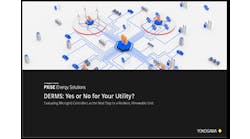By Lisa Cohn
September 18, 2008
Few topics we write about here draw as much attention as energy efficiency certificates. After we mention the certificates, we inevitably receive inquiries from data centers or other large energy users, who want more information.
The certificates also are called “white tags,” a term trademarked by marketer Sterling Planet. Interest in the certificates likely stems from the increasing use nationwide of a more established sister product, renewable energy certificates or green tags. Green tags come from renewable energy projects, while the newer white tags are generated by efficiency measures, like lighting retrofits, combined heat and power, and demand response.
Both white and green tags can be bought and sold. Utilities and other electricity retailers need them to meet mandates in certain states that they provide a set amount of their supply from clean or efficiency energy sources. Voluntary markets also exist for the tags throughout the country. In this case, companies or institutions buy the tags not to meet a law, but as an environmental gesture.
Connecticut has led the way in creating a white tag market. The state requires that utilities and electric retailers make efficiency 2% of their power portfolios this year. The requirement grows to 4% by 2010.
Here we provide a profile of a recent white tag project we unearthed in the files of the Connecticut Department of Public Utility Control. An IBM data center in the town of Southbury created the white tags and won approval September 12 of their validity under Connecticut rules.
IBM created the tags by installing 1,200 efficient lighting fixtures in October 2007 in its 846,000 square foot, three story building. The facility operates 8,760 hours per year. Specifically, IBM retrofitted 3-lamp, T-12 lamps and magnetic ballasts with more efficient T-8 lamps (two per fixture) and electronic ballasts. The fixtures will save the facility 829 megawatthours. IBM determined the savings by subtracting the energy it consumed after installing the new lighting from the energy it consumed before the installation.
The certificates are viable through March 31, 2018. The ending date is based on a state determination that the life of such efficiency projects is typically up to ten years. The facility must measure and verify savings each quarter and submit the results to the state.
Each MWh equals one certificate. The state does not set the price for the certificates – what IBM receives will depend on the market.
The company that helped IBM convert the efficiency savings into certificates was Neuwing Energy Ventures, 6 Evergreen Lane, East Haddam, Connecticut 06423.
For detailed information on the state’s conversion rules we suggest reviewing the Connecticut DPUC’s order setting up the program, DOCKET NO. 05-07-19. This can be found at the ‘in-active dockets database’ http://www.ct.gov/dpuc/cwp/view.asp?a=3364&q=413272.
Visit energy writer Lisa Cohn at www.realenergywriters.com and subscribe to his free EE Markets newsletter and podcast.






